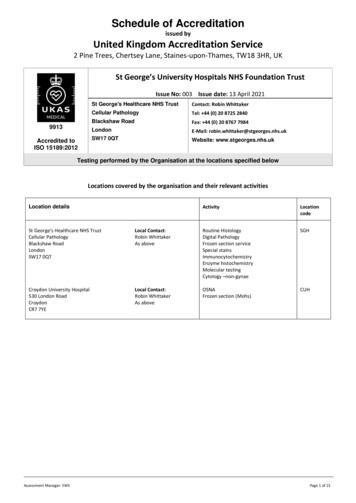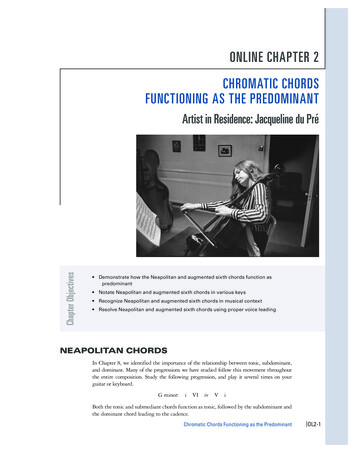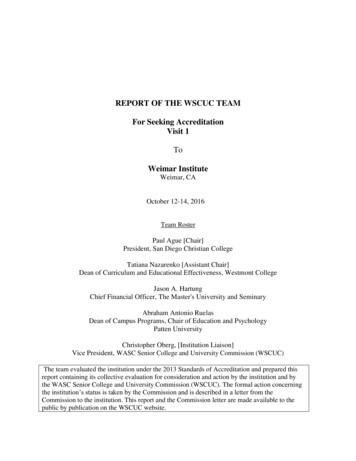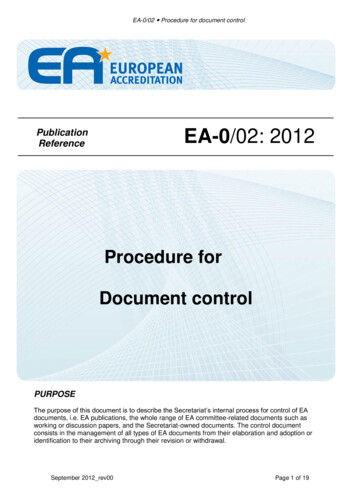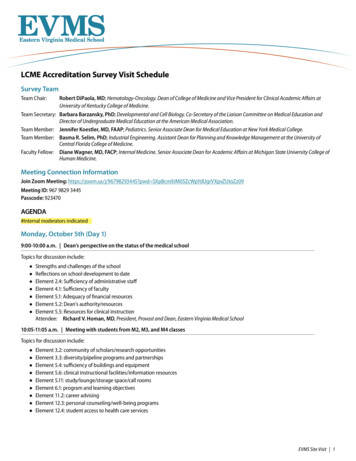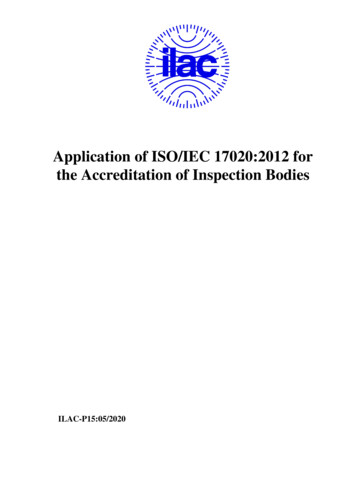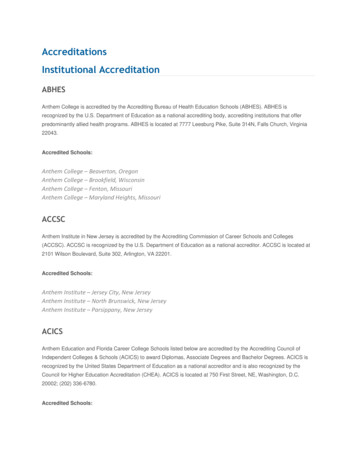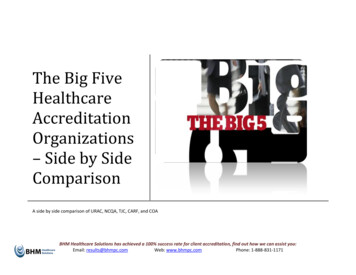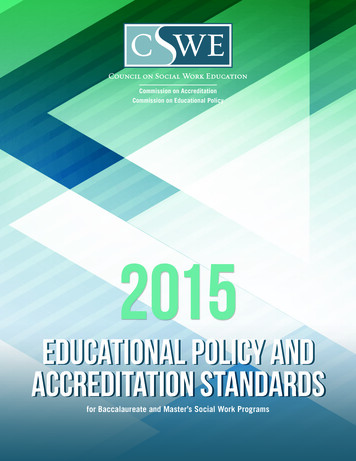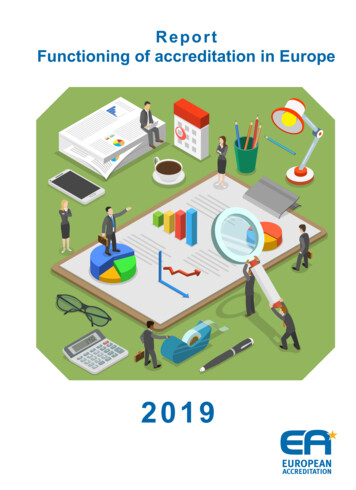
Transcription
ReportFunctioning of accreditation in Europe2019
Content1.Introduction2.Accreditation of conformity assessment bodies3.Survey on the functioning of accreditation in .24.6.34.74.7.14.7.24.84.9ResultsTotal number of accreditations by the end of 2018Total number of accreditations by the end of 2018 in the regulated sector based on Europeanand national legislationsNumber of accreditations in the non-regulated (voluntary) sector by the end of 2018Number of accreditations per activity by the end of 2018Number of accreditations ISO/IEC 17025 (testing)Number of accreditations ISO/IEC 17025 (calibration)Number of accreditations ISO 15189 (medical examination)Number of accreditations ISO/IEC 17020 (inspection)Number of accreditations ISO/IEC 17065 (product certification)Number of accreditations ISO/IEC 17021-1 (management system certification)Number of accreditations ISO/IEC 17024 (persons certification)Number of accreditations ISO/IEC 17043 (proficiency testing providers)Number of accreditations ISO 17034 (reference material producers)Number of accreditations ISO 14065 (GHG validation & verification)Main sectors/legislationsRegulated sectors with the most numbers of accreditationsNon-regulated sectors with the most numbers of accreditationsSectors/areas where NABs do not have know-howSuspension/withdrawal of accreditationNumber of accreditations which have been (completely) suspended in 2018Number of accreditations which have been (completely) withdrawn in 2018Number of accreditations which have been reinstated (lifting suspension/withdrawal) in 2018Complaints/AppealsComplaintsAppealsAcceptance of accreditationChallenges for National Accreditation Bodies5.Summary04 October 2019Page 2 of 44
1.IntroductionMore than 10 years ago, the European Commission published Regulation (EC) No 765/2008 with the aimto ensure that products benefiting from the free movement of goods within the Community fulfilrequirements providing a high level of protection of public interest such as health and safety in general,health and safety at the workplace, protection of consumers, protection of the environment andsecurity, while ensuring that the free movement of products is not restricted to any extent greater thanthat which is allowed under Community harmonisation legislation or any other relevant Communityrules.In order to reach these objectives, it was necessary to establish an overall framework of rules andprinciples in relation to accreditation, conformity assessment and market surveillance.Regulation (EC) No 765/2008 provides a comprehensive framework for accreditation and to lay down atCommunity level the principles for its operation and organization.The particular value of accreditation lies in the fact that it provides an authoritative statement of thetechnical competence of bodies whose task is to ensure conformity with the applicable requirementsproviding a high level of protection of public interest.Moreover, transparent accreditation, as provided for in Regulation (EC) No 765/2008, should beconsidered by the national public authorities as the preferred means of demonstrating the technicalcompetence of conformity assessment bodies (CABs).Due to the new accreditation system set out in Regulation (EC) No 765/2008, the number of Europeanlegislations with reference to accreditation and conformity assessment has been increased significantly.Accreditation is also the preferred tool to demonstrate the competence of CABs in trade agreementswith third countries with the aim of mutual acceptance of conformity assessment results and with thatavoiding technical barriers to trade.Accreditation is also the appropriate means that consumers (end-users) can have trust directly incertificates and reports issued by accredited conformity assessment bodies.The European Commission confirmed in its report on the implementation of Regulation (EC) No765/2008 1, that the European accreditation infrastructure created by Regulation (EC) No 765/2008 hasprovided added value, not only for the single market but also for international trade.Accreditation has wide support from European industry and the conformity assessment community forensuring that products meet the applicable requirements, removing barriers for CABs and helpingentrepreneurial activities to flourish in Europe. The Regulation established a trustworthy and stableaccreditation system in all Member States, as well as EFTA countries and Turkey.1Report, dated 19th of December 2017, from the Commission to the European Parliament, the Council and theEuropean Economic and Social Committee on the implementation of Regulation (EC) No 765/2008 of the EuropeanParliament and of the Council of 9 July 2008 setting out the requirements for accreditation and market surveillancerelating to the marketing of products and repealing Regulation (EEC) No 339/9304 October 2019Page 3 of 44
But how accepted is accreditation in Europe and used by the European and national authorities as wellas private scheme owners/users as the preferred means to demonstrate competence of CABs and howrobust is the accreditation system?EA has been requested by the European Commission to provide specific indicators, which shall provideinformation about the functioning of accreditation in Europe. This information shall be providedregularly in future and shall complement the information presented in the Commission’s report on theimplementation of Regulation (EC) No 765/2008.2.Accreditation of conformity assessment bodiesAccreditation of CABs is defined in Regulation (EC) No 765/2008 and in ISO/IEC 17011.The international standard ISO/IEC 17011:2017 Conformity assessment - Requirements for accreditationbodies accrediting conformity assessment bodies defines accreditation as follows:Third-party attestation related to a conformity assessment body conveying formal demonstration of itscompetence to carry out specific conformity assessment tasks.Conformity assessment activities, being performed by CABs, are for instance testing, calibration,inspection, certification of management systems, persons, products, processes and services,provision of proficiency testing, production of reference materials, validation and verification.According Regulation (EC) No 765/2008 ‘accreditation’ shall mean an attestation by a nationalaccreditation body that a conformity assessment body meets the requirements set by harmonisedstandards and, where applicable, any additional requirements including those set out in relevant sectoralschemes, to carry out a specific conformity assessment activity.The harmonised standards for accreditation are published in the Official Journal of the European Union(OJEU).There are the following harmonized standards applied for the accreditation of CABs:EN ISO/IEC 17025:2017 General requirements for the competence of testing and calibrationlaboratoriesEN ISO 15189:2012Medical laboratories - Requirements for quality and competenceEN ISO/IEC 17020:2012 Conformity assessment - Requirements for the operation of various types ofbodies performing inspectionEN ISO/IEC 17065:2012 Conformity assessment - Requirements for bodies certifying products,processes and servicesEN ISO/IEC 17021-1:2015 Conformity assessment - Requirements for bodies providing audit andcertification of management systems -- Part 1: RequirementsEN ISO/IEC 17024:2012 Conformity assessment - General requirements for bodies operatingcertification of persons04 October 2019Page 4 of 44
EN ISO 14065:2013EN ISO/IEC 17043:2010EN ISO 17034:2016Greenhouse gases - Requirements for greenhouse gas validation andverification bodies for use in accreditation or other forms of recognitionConformity assessment - General requirements for proficiency testingGeneral requirements for the competence of reference material producersIf we are talking about accredited CABs, then we have to look always to the scope of accreditation. Insome cases, the CAB is not accredited for the whole conformity assessment activities which are offeredby this CAB to the market, but only for a part of these activities.Definition of scope of accreditation (ISO/IEC 17011:2017, clause 3.6)Specific conformity assessment activities for which accreditation (see above) is sought or has beengranted.For more information about accreditation and conformity assessment, please visit EA’s y on the functioning of accreditation in EuropeEA launched a survey in June/July 2019 to all 50 EA National Accreditation Bodies (36 EA Full2 and 14Associate3 members) with the aim to receive information about: Number of accreditations (by end of 2018)- Number of accreditations in the regulated sector- Number of accreditations in the non-regulated (voluntary) sector Number of accreditations per activity (by end of 2018) Main sectors/legislations with the most number of accreditations Suspension/withdrawal of accreditation Complaints/appeals Acceptance of accreditation ChallengesThis information shall be used for the analysis of the functioning of accreditation in Europe.2EA Full members:NABs legally appointed as referred to in Regulation (EC) No 765/2008 in:- a member state of the EU; or- a member state of the EFTA; or- a country which has been formally identified by the EU or EFTA as a candidate countryfor membership in the EU or EFTA.3EA Associate members: NABs legally appointed as such by countries or economies being:- identified by the EU or EFTA as potential candidate countries or economies for EU orEFTA membership; or- identified by the EU in the European Commission’s European Neighbourhood Policy ascountries or economies of particular importance.04 October 2019Page 5 of 44
EA received responses from 34 Full members and 11 Associate members:AA, AustriaACCREDIA, ItalyARMNAB, ArmeniaATCG, MontenegroAZAK, AzerbaijanBATA, Bosnia & HerzegovinaBELAC, BelgiumBSCA, BelarusCAI, Czech RepublicCOFRAC, FranceCYS-CYSAB, CyprusDAK, KOSOVO (under the UNSCResolution 1244/1999)DAkkS, GermanyDANAK, DenmarkDPA, AlbaniaEAK, EstoniaEGAC, EgyptENAC, SpainESYD, GreeceFINAS, FinlandGAC, GeorgiaHAA, CroatiaIARNM, Republic of NorthMacedoniaINAB, IrelandIPAC, PortugalISAC, IcelandISRAC, IsraelLA, LithuaniaLATAK, LatviaMOLDAC, Republic of MoldovaNA, NorwayNAAU, UkraineNAB-Malta, MaltaNAH, HungaryOLAS, LuxembourgPCA, PolandRENAR, RomaniaRvA, The NetherlandsSA, SloveniaSAS, SwitzerlandSNAS, SlovakiaSWEDAC, SwedenTUNAC, TunisiaTURKAK, TurkeyUKAS, United Kingdom2 Full member and 3 Associate members, which have responded to the survey, are not signatories to theEA MLA.For more information about the EA Multilateral Agreement for Recognition (MLA) and about EAmembers and their MLA signatory status please visit the EA website tal number of accreditations by the end of 2018The total number of accreditations under the EA MLA continues to rise. By the end of 2018, more than35.250 accreditation have been granted in total by all EA National Accreditation Bodies (NABs) comparedto 35.100 by the end of 2017 and 34.600 by the end of 2016.04 October 2019Page 6 of 44
The total number of accreditations granted by the NABs, which responded to this survey, is 34.064.The number of accreditations is equivalent to the number of issued accreditation certificates. But someconformity assessment bodies hold more than one accreditation, because in general the NABs issue foreach activity (e.g. testing according ISO/IEC 17025 or product certification according ISO/IEC 17065) anaccreditation certificate. That means that the number of accredited CABs is slightly lower than thenumber of granted accreditations.The EA NABs issued more than 2.400 new accreditations in 2018.04 October 2019Page 7 of 44
The increasing number of accreditations demonstrate the confidence in accreditation and in certificatesand reports issued by accredited CABs.The process of accreditation is defined in ISO/IEC 17011 (see above item 2). The NAB shall apply anassessment programme for assessing the CAB activities during the accreditation cycle to ensure that theconformity assessment activities - representative of the scope of accreditation at the relevant locations are assessed during the accreditation cycle.The assessment programme shall also ensure that the requirements of the international standards (seeabove item 2) and other normative documents containing requirements for CABs and the scope ofaccreditation shall be assessed taking risk into consideration. A sample of the scope of accreditation shallbe assessed at least every two years. The time between consecutive on-site assessments shall notexceed two years. The re-assessment shall take place after 5 years at the latest of the previous initial orre-assessment. It shall confirm the competence of the conformity assessment body and cover all therequirements of the standard(s) for which the conformity assessment body is accredited.The outcome of the re-assessment is the so-called re-accreditation or renewal of the accreditation basedon a positive decision by the NAB.In 2018, the EA NABs have issued in total more than 6.000 re-accreditations.4.2Total number of accreditations by the end of 2018 in the regulated sector based on Europeanand national legislationsIn many European and national legislations regulators make use of accreditation as the preferred meansto demonstrate the competence of CABs.04 October 2019Page 8 of 44
Examples of those European legislations are the Directive 2014/68/EU on pressure equipment, theRegulation (EU) No 305/2011 on construction products and the Regulation (EC) No 882/2004 on officialcontrols in the agri-food sector.Currently, there are more than 100 European legislations with reference to accreditation and conformityassessment. Additionally, the national regulators make use of accreditation too.The NAB shall provide information on th
04.10.2019 · inspection, certification of management systems, persons, products, processes and services, provision of proficiency testing, production of reference materials, validation and verification. According Regulation (EC) No 765/2008 ‘accreditation’ shall mean an attestation by a national
